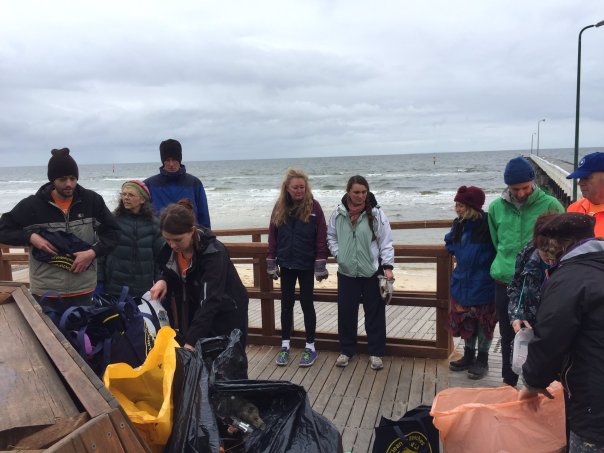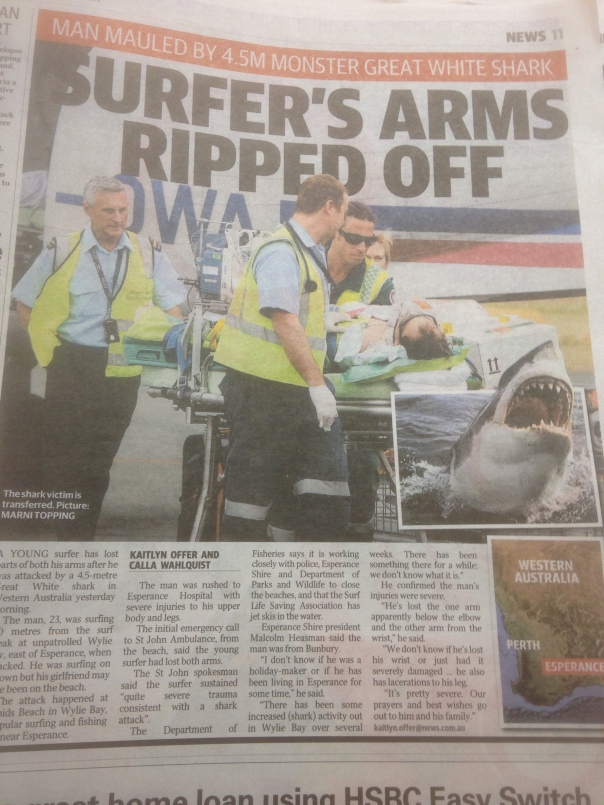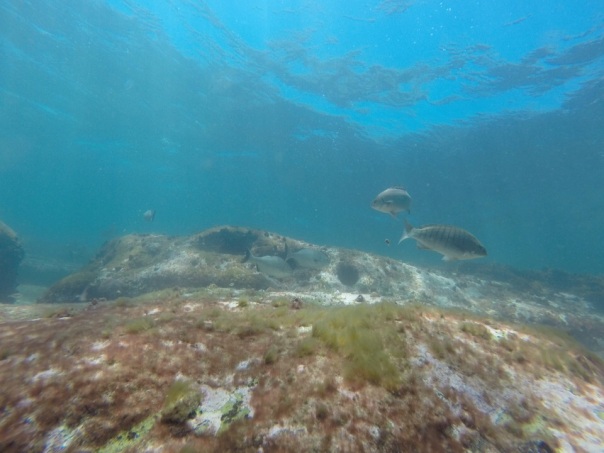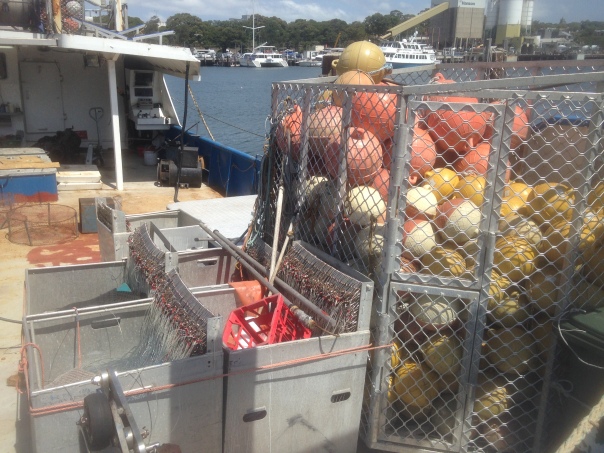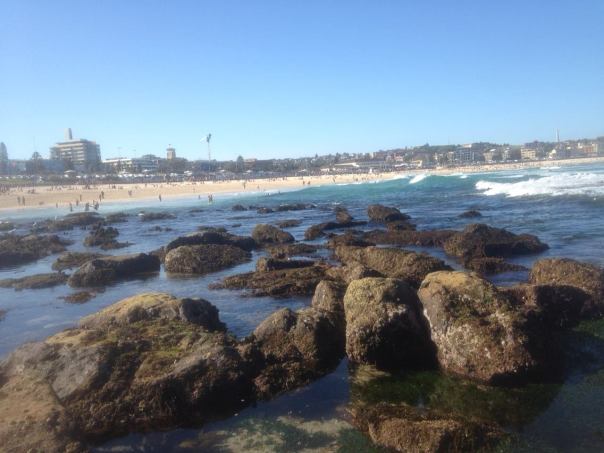Blog Archives
Dirty secrets revealed during International Coastal Cleanup Day
I’d been threatening to join the Seaford Beach Patrol group for months to take part in their monthly cleanup and, seeing as I helped them join the International Coastal Cleanup Day movement, thought I should finally get along to the cleanup on the 18th of September. Weather was the standard Melbourne September grey and cold, which didn’t deter 17 locals from turning out to collect more than 35kg of rubbish in a one-hour stint along a 200-300m stretch of our bay beach.
Apart from the scary numbers of cigarette butts, plastic-based food wrappers, bottles, tin cans and foam pellets, the cleanup revealed some surprising finds shown in this table below:
Considering lollypops (usually Chupa Chup style but varied in size) are not the fashionable thing they once were, it might be that recent storms and winter king tides have revealed layers of historic plastic waste, and also dumped a larger than expected amount of foam and plastic on this stretch of beach. And the old saying about lost socks turning up in the damnedest places holds true, though why there were two socks and four shoes found is anyone’s guess.
Greenland sharks can live to 400 years old, only reach sexual maturity at 150
Researchers using radiocarbon dating have determined that Greenland sharks, slow-moving giants that live in the cold, dark waters of the North Atlantic, are the longest-living vertebrates on Earth, with one recorded as being 400 years old. Which explains the old Greenland shark quip that goes something like: “God must like practical jokes; why would He make […]
via Scientists say Greenland sharks can live for 400 years — The Cotton Boll Conspiracy
COP21 – the world weighs in
The Paris terrorist attacks weighed pretty heavily on the attendees of COP21 and tightened security around the venues, resulting in protest marches being banned and the unusual sight of shoes in place of marchers.
Conservationists, as expected, took to social media to get in on the conversations denied after being shut out of the French capital and the UN Climate Talks Live Feed gives a great rundown of the discussions from various levels from negotiators to participants and media around the event.
Check out the Civil Society Representatives feed for one – doesn’t include some of the expected organisations and it’s a concern to see climate change skeptic Bjorn Lomberg and downright tool in the top three posters today (Monday 30 November).

Lizard Island provokes paradise envy with its #FeatureScientists posts
Living in the cooler climes of south-eastern Australia, I’m often envious of the crew working at the Lizard Island Reef Research Station and other Great Barrier Reef islands.
While there are some pretty amazing (but less colourful) reef and seafloor communities not far from my home on Port Phillip Bay, I still have to make do with reports on tropical research for my daily warm-water, coral reef region fix. This one below focused on the humble cleaner wrasse and its affect on algae growth – loss of these fish can also lead to increased coral bleaching.
Our first feature scientist was Eva McClure, part of Dr. Lexa Grutter‘s lab team. Dr. Grutter, of the University of Queensland, investigates how the cleaner wrasse, Labroides dimidiatus, influence the ecology of coral reef communities. For the past 15 years, she has run a study on Lizard Island, which sees these fish removed from isolated ‘patch reefs’, and then observes the affect their removal has on the reefs.
Eva has been working for Lexa for the past 3 years. She is currently on Lizard Island wrapping up a 2-year component of Dr. Grutter’s larger, long-term study. In this project, terracotta pavers were placed on the reefs in July 2013, to investigate how the absence of cleaner wrasse may indirectly influence the benthic community (organisms living in the benthic zone are those living at the lowest level of a body of water).
Lexa’s team have found that reefs without cleaner wrasse attract less herbivorous fish than reefs that offer cleaning services (those that have cleaner wrasse present). Reefs without cleaners may therefore have more algae compared to reefs with cleaners, as there are less large herbivorous fish grazing on the benthic community. By placing out algae-coral settlement pavers and periodically measuring the abundance and height of the algae, Eva (as part of Dr. Grutter’s team), hope to make a definitive determination as to whether cleaner wrasse population affects algae levels.
To wrap this project up, a final underwater measurement and photograph is taken (photos 1 and 2), before collecting all 200 pavers, checking them for coral recruits (3) and scraping them of turf algae, calcerous algae, coral recruits and other encrusting organisms. The product is then dried, weighed and taken back to the University of Queensland for analysis.
In Eva’s own words: “It’s exciting and quite satisfying finishing up a 2 year long project like this one, especially when it involves working in a beautiful place like Lizard Island!”
Shark Attack 2: Revenge of the Tabloid Headline Writer
When I was Sydney last October, preparing for the IUCN World Parks Congress with the French marine protected areas agency, this headline above was splashed in similar formats across several Australian newspapers.
Shark scientists were kept very busy responding to misinformation, stupidity and downright dangerous reporting in the Australian spring and summer – and this headline (and the strapline above it about the ‘4.5m monster’ shark) summed up the challenge they and shark conservationists face. It was absurd for the writer and editor to let this go through:
- the surfer’s arms were not ‘ripped off’, the writers make it clear in the introduction that he lost parts of both arms
- a 4.5m shark (if that was even the correct size) is not a monster in size. If it had been a validated sighting of a 6m white shark, I would have been more impressed.
My most popular article from this irregularly-updated blog is another shark attack post that made exactly the same criticisms I can make two years later. I image the people googling that phrase came across the post, saw it was attaching the whole tabloid concept of ‘shark attacks’ and left to find juicy photos of actual shark encounters.
Because that’s what these incidents are: encounters. The increased populations around coastal areas in the warmer months, coupled with overfishing of shark prey species, surfers spending longer in the ocean due to thicker and more comfortable wetsuits, climate change and other unpredictable factors, is leading to more encounters with sharks. And if one in 1000 of those encounters ends in a shark bite, we shouldn’t be surprised every time and call for that shark’s head. This only supports the view of shark fishers that they are removing dangerous animals from the ocean, rather than murdering an endangered animal (in the case of some shark species).
Australian Geographic posted a great article about shark research that revealed we are to blame for shark attacks due to the factors mentioned above. And no matter how big a year we have for shark ‘assaults’, it pales in creation to deaths from car crashes, domestic injuries and even bee stings:
So far in 2011, there have been at least 61 recorded attacks and 10 deaths. However, compared to deaths from smoking, road accidents, lightning strikes or even other animal attacks, the risk is minute, say experts.
So please can we stop with the tabloid shark bashing, stick to the boring but correct title of shark encounters and help target the real villains in this debate: fishing trawlers that are destroying the shark-prey food chain and governments who keep approving shark hunting after each encounter in the misguided view that killing that one ‘manhunter’ shark will end the chance of any further shark bites.
#WorldParksCongress wraps up #WPCMarine
I worked some of the longest days of my career at World Parks Congress and dealt with a variety of event teething issues never experienced before. On the upside, I met some amazing people (including the wonderful Sylvia Earle, who I interviewed for our webtv channel) and worked with a great team from the French Marine Protected Areas Agency. Please make sure you check out our videos at http://oceanplus.tv/en/
From Hardliners TV star to rusting away at a Sydney pier
Since digital television hit Australia a few years ago, the influx of new channels an increase in airtime has not only surprised audiences but broadcasters as well.
Channel 10’s digital offering, with the bland and unhelpful title ONE (since I’ve never seen it linked to an actual channel 1 on any digital TV) showed early promise as a sports broadcaster but switched to mostly reality offerings.
One of the better shows they picked up from cable TV was Hardliners, which featured tuna longline boat captains plying their trade. It was an attempt to show the ‘battle’ between captains for bragging rights but did more in showing how tough it becomes to just break even when chasing endangered or critically endangered species (for those targeting Southern Bluefin Tuna at least). Conservation issues aside, it did feature some colourful characters, as you’d expect on any commercial fishing boat not captained by George Clooney.
While checking out Sydney Fish Market this week (another shadow of its former self), I spotted a tuna longliner docked close to the market. A nearby tackle shop owner told me the ship, Santo Rocco Di Bagnara, was captained by Tony Lagana in the Hardliners series but had now been out of the water (not literally) for about 12 months.
Whether it was commercial licence or storage capacity issues was unclear – the shop owner said the boat had been also used for crabbing and had discovered some new territory with abundant edible crab species but had, in his perspective, been unfairly targeted by NSW Fisheries and forced out of the game.
Many conservationists would be cheering at the loss of a tuna longline boat but the news made me (not so secretly) wish I could spend a day on board one of these boats – to see firsthand the fish they are catching, the amount and type of bycatch picked up and the sort of people who work commercial boats these days. My guess is they are less George Clooney/Mark Wahlberg types and more like the Hardliner boys, many of whom actually care about sustainable fishing as well as trying to make a buck.
Train to airport to Sydney to home to writing essays to airport again…
Can’t complain about having too much work lately (and seeing the latest unemployment figures there’s nothing I can whinge about that would gain me any sympathy) and I’m off to Sydney again on Sunday for more World Parks Congress preparation with L’Agence des aires marines protégées (French Agency for Marine Protected Areas).
I was lucky to head down to check out Bondi Beach one afternoon between meetings and phone calls. Growing up in northern Sydney, Bondi was always seen as a tourist beach where us northerners never ventured – now I’m a tourist in my birthplace so can throw out those old preconceptions!
Really looking forward to the Congress and meeting people from around the world who are keen on protecting our land and marine parks. I’ll be back there for three weeks in November, just after finishing my final exam of my Marine Biology degree!!! Hope to get the chance for a few beers to celebrate that and also the exciting news of scoring a new job in Melbourne. It will be sad to leave Warrnambool – anyone who has read this blog will get the idea I’m partial to living down here but with a six-month-daughter now in our lives and better job opportunities in the big city, it makes sense to head back there.
Shark Week snubs scientists, increases fear of sharks
As is becoming common this time of year, my Twitter feed has been swamped with Shark Week vitriol – from swimmers who are now more afraid to go in the water to scientists angry at the lack of consultation that goes into a few of the fake documentaries appearing during the event.
Apart from the fact Discovery Channel ignores the rest of the world when it comes to sharing Shark Week with non-Americans, from what I’ve seen of the clips there seems to be a dearth of well-researched, informative programming.
Christie Wilcox writes for the Discover Magazine and her summaries of the week should be required reading for anyone watching Shark Week, including this post on falling ratings and viewer angst:
“It’s the third day of Shark Week, and Discovery has already come under fire for their programming choices. Their big special on kick-off night—Shark of Darkness: The Wrath of Submarine—turned out to be another fake documentary, making up people and events to perpetuate the idea that a 30+ ft long great white patrols the coast of South Africa. The legend of Submarine is a particularly fishy topic choice, as its origin can be traced to the 1970s when some journalists decided to make up a story to see how gullible their readers were.”
As some commenters have noted this week, if the focus was spread from great whites to lesser-known threatened species of sharks, their public profile and survival chances might improve. A great white throwing a seal pup in the air or biting a cage might make for exciting TV but shouldn’t the week be about promoting all sharks, not just the most photogenic ones?
New shellfish reefs to be planted in Victorian bay
Dredging and bottom trawling of Port Phillip Bay in Victoria have destroyed most of the natural shellfish reefs in the 230 years since European settlement of Australia.
This new plan reported in the Age newspaper last week will help to restore shellfish reefs in the bay with the aim of increasing habitat for flathead, snapper and other commercially and recreationally valuable fish.
Shellfish reefs will be re-created on the bottom of Port Phillip Bay in a historic project that aims to improve marine habitats in Victoria’s largest bay.
Researchers say that if the reefs can be successfully established as expected, they would provide healthy habitats for shellfish like mussels and oysters. They would also provide habitat, shelter and food options for fish such as snapper, flathead, rockling and many other fish that live in the bay. They would also help improve water quality.
Shells from mussels, scallops and oysters that have been discarded by the seafood industry and restaurants could be sought as part of the project. They would eventually be placed in the bay at one of three locations, in order to form a base for the early stage of the shellfish reefs. Some artificial material could also be used.
But the project requires more than old shells. Millions of baby oysters and mussels, which will be bred at the Victorian Shellfish Hatchery at Queenscliff, will be used to colonise the reefs in the $270,000 pilot project. The baby oysters and mussels will attach themselves to shells at the hatchery, before they are placed in the water on top of the old shells.
The project, to commence this year, is expected to be formally announced on Saturday by Agriculture Minister Peter Walsh, the minister responsible for fisheries. It will be funded jointly, with $120,000 from the state’s Recreational Fishing Initiative, and $150,000 from The Nature Conservancy, an international organisation that undertakes conservation works around the world.
A patchwork of reefs will be restored at three locations, near Geelong, Chelsea and St Kilda, in about eight to 12 metres of water.

